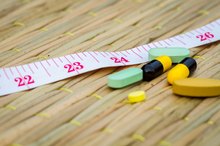What Causes False Positives in Marijuana Drug Testing?
Drug testing has become a way of life in our culture. It is now required with many job applications and for participation in school athletic programs. Testing for marijuana most often consists of a urine test, according to the Centers for Disease Control and Prevention 12. While most people who do not use marijuana will test negatively for the substance, some medications can cause a false positive reading 4. It is wise to bring all medications along when you're being tested for marijuana.
If you are experiencing serious medical symptoms, seek emergency treatment immediately.
Methodolgy and Human Error
According to the Centers for Disease Control and Prevention, marijuana is the most widely used illegal drug in the United States 12. The urine test for marijuana is based on the detection of 9-carboxy-THC, a metabolite of the primary active component in marijuana 1. A urine test used by many labs is EMIT, or enzyme multiplied immunoassay technique. According to NORML, a group devoted to marijuana legalization, this test itself is prone to errors. Human errors, such as labeling errors, inadequate training of laboratory staff and fatigue or boredom are also possible and capable of producing a false positive result.
- According to the Centers for Disease Control and Prevention, marijuana is the most widely used illegal drug in the United States 1.
- According to NORML, a group devoted to marijuana legalization, this test itself is prone to errors.
Protonix
What Causes a False-Positive Drug Test for Meth?
Learn More
Protonix--generic name pantoprazole sodium--is a proton pump inhibitor used in the treatment of GERD 3. Protonix' manufacturer warns that it can cause a false positive reading for marijuana, according to Drugs.com 3. People taking Protonix should always bring the prescription bottle with them to show the laboratory staff when drug testing is done 3.
NSAIDs
NSAIDs, or non-steroidal anti-inflammatory medications, such as:
- ibuprofen
- Orudis KT
- Advil
- Motrin
- Aleve
- were once thought to cause false positive readings for marijuana
According to NORML, this is no longer the case due to improved testing methods. Other sources, such as Star Detox, still list the above medications as being able to cause false positive readings for marijuana 4. The best thing to do would be to bring all medication bottles with you when you are tested.
Dronabinol
Common Substances Causing False Positives for Amphetamines in Drug Tests
Learn More
Marinol, generic name dronabinol, is a medication widely used to combat the nausea and vomiting associated with chemotherapy, according to the U. S. Drug Enforcement Agency. The active ingredient in Marinol is synthetic THC. It is also called "medical marijuana" and will cause a positive reading for marijuana in a drug test. Anyone on Marinol therapy should bring their prescription bottle with them when having any drug testing done.
- Marinol, generic name dronabinol, is a medication widely used to combat the nausea and vomiting associated with chemotherapy, according to the U. S. Drug Enforcement Agency.
- Anyone on Marinol therapy should bring their prescription bottle with them when having any drug testing done.
Other Factors Thought To Cause A False Positive
Documentation of the disease, or the pill bottle for any of the medications listed, should be brought along to show to the laboratory staff during any drug testing.
Related Articles
References
- Centers for Disease Control and Prevention: Urine Testing for Detection of Marijuana: An Advisory
- Star Detox: Medications & Substances Causing False Positive Drug Test
- Huestis MA. Human cannabinoid pharmacokinetics. Chem Biodivers. 2007;4(8):1770-804. doi:10.1002/cbdv.200790152
- National Institute on Drug Abuse. Marijuana. Updated September 2019.
- Kulig K. Interpretation of workplace tests for cannabinoids. J Med Toxicol. 2017;13(1):106-110. doi:10.1007/s13181-016-0587-z
- Doucette M, Frattaroli S, Vernick J. Oral fluid testing for marijuana intoxication: enhancing objectivity for roadside DUI testing. BMJ Intervention. 2016;24(1). doi:10.1136/injuryprev-2016-042264.
- Taylor M, Lees R, Henderson G, Lingford-Hughes A, Macleod J, Sullivan J, Hickman M. Comparison of cannabinoids in hair with self-reported cannabis consumption in heavy, light and non-cannabis users. Drug and Alcohol Review. 2017. doi:10.1111/dar.12412.
- Wong A, Montebello ME, Norberg MM, Rooney K, Lintzeris N, Bruno R, Booth J, et. al. Exercise increases plasma THC concentrations in regular cannabis users. Drug and Alcohol Dependence. 2013;133(2):763-7. doi:10.1016/j.drugalcdep.2013.07.031.
- Center for Disease Control. Marijuana and Public Health. Updated March 7, 2018.
- Doucette M, Frattaroli S, Vernick J. Oral fluid testing for marijuana intoxication: Enhancing objectivity for roadside DUI testing. BMJ Intervention. 2016;24(1). doi:10.1136/injuryprev-2016-042264.
- Meier M. Associations between butane hash oil use and cannabis-related problems. Drug and Alcohol Dependence. 2017;179:25-31. doi:10.1016/j.drugalcdep.2017.06.015.
- Taylor M, Lees R, Henderson G, Lingford-Hughes A, Macleod J, Sullivan J, Hickman M. Comparison of cannabinoids in hair with self-reported cannabis consumption in heavy, light and non-cannabis users. Drug and Alcohol Review. 2017. doi:10.1111/dar.12412.
- U.S. Department of Health & Human Services. Learn About Marijuana Risks. SAMHSA website. Updated September 26, 2019.
- Wong A, Montebello ME, Norberg MM, Rooney K, Lintzeris N, Bruno R, Booth J, et. al. Exercise increases plasma THC concentrations in regular cannabis users. Drug and Alcohol Dependence. 2013;133(2):763-7. doi:10.1016/j.drugalcdep.2013.07.031.
Writer Bio
Kathryn Meininger began writing and publishing poetry in 1967. She was co-founder and editor of the professional magazine "Footsteps" and began writing articles online in 2010. She earned a Doctor of Podiatric Medicine from Temple University School of Podiatric Medicine and a Bachelor of Arts in biology from William Paterson University.








